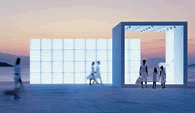Light
Light is a natural phenomenon, vital to our very existence, which we probably take for granted in every day life. But the quality and intensity of light around us totally affects our visual appreciation and understanding of our surroundings.
Radiation Spectrum
So what is this phenomenon called light?
Basically it’s an emission of energy called electromagnetic radiation.
Electromagnetic radiation occurs in many forms and the whole spectrum is measured in wavelengths. The radio waves at the top end have wavelengths of many kilometres, while the gamma rays at the other have wavelengths smaller than the size of atoms.
Light represents only a small section of this whole spectrum and are the only ray visible to the human eye.
Visual Spectrum
This region of visible light extends from 380 to 760 nanometres, a nanometre being one millionth of a millimetre, and the different wavelengths are directly related to the colour of the rays.
The shorter the waves, the more blue they appear. The longer the waves, the more red they appear.
Splitting White Light
To illustrate those different colours that make up the 'white light’ we see, we can consider and experiment first performed by Sir Isaac Newton.
He directed a ray of white light through a prism which split various colours to form a spectrum.
Newton believed he was colour blind, so he asked his assistance to describe the colours he saw and was delighted when he described seven:
- Red
- Orange
- Yellow
- Green
- Blue
- Indigo
- Violet
For modern day lighting science, we use the broader description of three distinct colours:
Red, Green and Blue, with a narrow yellow region between the red and green.
|



